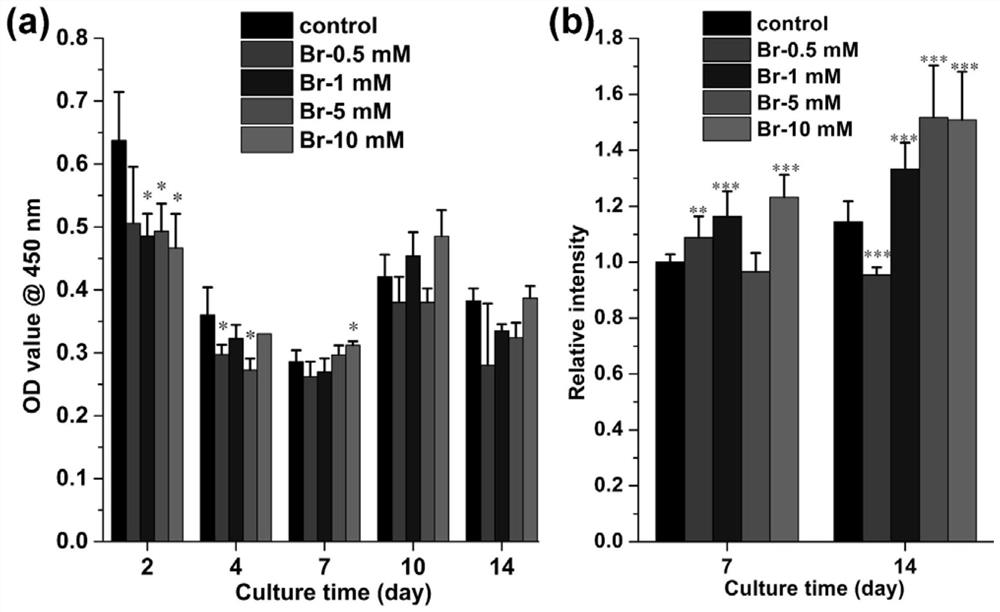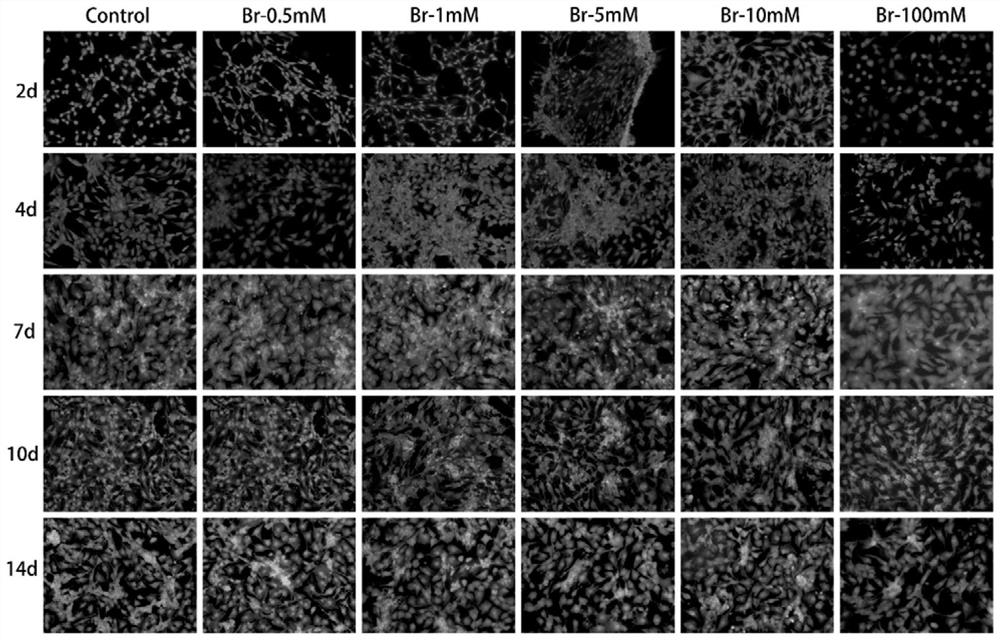Application of Bromide Ion in Cartilage Tissue Engineering
A technology of cartilage tissue and bromide ions, applied in bone/connective tissue cells, medical science, prosthesis, etc., can solve the problems of increased subchondral bone density, secondary articular cartilage degeneration, and inability to significantly improve joint pain, etc. Achieve the effects of promoting cartilage repair, broad application prospects, and excellent in vitro biological activity
- Summary
- Abstract
- Description
- Claims
- Application Information
AI Technical Summary
Problems solved by technology
Method used
Image
Examples
Embodiment 1
[0034] Embodiment 1 bromide ion (Br - ) on the differentiation of chondrocytes
[0035] Mouse embryonic tumor cells ATDC5 (purchased from Shanghai Lianmai Bioengineering Co., Ltd.) were inoculated in 96-well plates, and the cells were placed in DMEM / F12 medium containing different concentrations of bromide ions at 37°C and 95% humidity in carbon dioxide (CO 2 ) in an incubator. In examining the bromide ion (Br - ) on the influence of chondrocyte differentiation, the bromide ion solutions of 0.5mM, 1mM, 5mM, 10mM and 100mM which were prepared with NaBr were set.
[0036] 1. Cell Proliferation Assay
[0037] On the 2nd, 4th, 7th, 10th, and 14th day of ATDC5 cell culture, the proliferation of cells in different media was detected by using CCK-8 kit (purchased from DOJINDO, Japan). On the 2nd, 4th, 7th, 10th, and 14th day of cell culture, aspirate the original medium, and add 110 μL of medium mixed with CCK-8 reagent (per 100 mL of DMEM / F12 medium mixed with 10 mL of CCK-8 8 ...
Embodiment 2
[0052] Characterization of the influence of embodiment 2 bromide ions on cartilage calcification
[0053] The differentiation medium used in this example was prepared by adding the following final concentrations of the components in common DMEM (Gibco) medium: 100 nM dexamethasone (Sigma, USA), 50 μg / mL vitamin C (Sigma, USA), 100 μg Sodium pyruvate / mL (Aladdin, China), 40 μg / mL proline (Aladdin, China), 1 vol% ITS (West, USA), 1 vol% double antibody (penicillin / streptomycin, brand Gibco).
[0054] Mouse embryonic tumor cells ATDC5 were stored in DMEM medium supplemented with 5% fetal bovine serum at 37°C and 95% humidity in CO 2 cultured in an incubator. When the cell density in the culture flask reached 90-95%, the cells were trypsinized and centrifuged for passage. After the cells were expanded to the required number for the experiment, the cells were digested with trypsin and centrifuged to collect the cells. 5 Density per well The cells were seeded in 96-well culture p...
Embodiment 3
[0057] The preparation of embodiment 3 loaded bromide ion microspheres
[0058] This example utilizes polylactic acid-co-glycolic acid (PLGA) to prepare loaded Br - PLGA microspheres.
[0059] PLGA was dissolved in dichloromethane, containing Br - The aqueous solution (NaBr aqueous solution) was added dropwise therein to prepare colostrum; then the colostrum was added dropwise to 1.5% polyvinyl alcohol aqueous solution, stirred in an ice bath for 6 h, and then stirred at room temperature for 24 h to obtain the loaded Br - PLGA microspheres.
PUM
 Login to View More
Login to View More Abstract
Description
Claims
Application Information
 Login to View More
Login to View More - R&D
- Intellectual Property
- Life Sciences
- Materials
- Tech Scout
- Unparalleled Data Quality
- Higher Quality Content
- 60% Fewer Hallucinations
Browse by: Latest US Patents, China's latest patents, Technical Efficacy Thesaurus, Application Domain, Technology Topic, Popular Technical Reports.
© 2025 PatSnap. All rights reserved.Legal|Privacy policy|Modern Slavery Act Transparency Statement|Sitemap|About US| Contact US: help@patsnap.com



